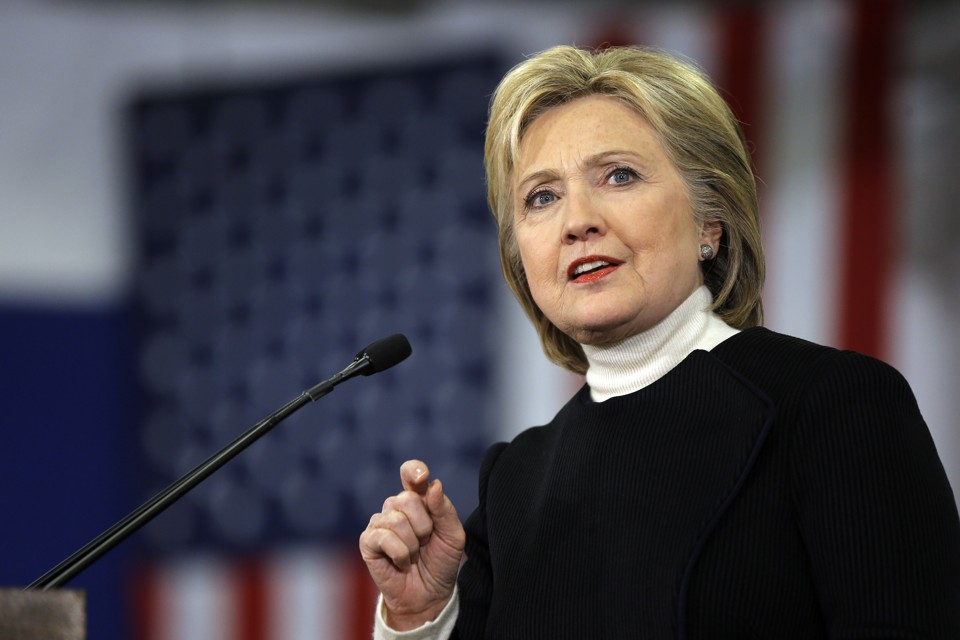We are living in a volatile political environment. You know, to just be grossly generalistic, you could put half of Trump’s supporters into what I call the basket of deplorables. Right? The racist, sexist, homophobic, xenophobic, Islamophobic — you name it. And unfortunately there are people like that. And he has lifted them up. He has given voice to their websites that used to only have 11,000 people — now 11 million. He tweets and retweets their offensive hateful mean-spirited rhetoric. Now, some of those folks — they are irredeemable, but thankfully they are not America.
But the other basket — and I know this because I see friends from all over America here; I see friends from Florida and Georgia and South Carolina and Texas, as well as, you know, New York and California — but that other basket of people are people who feel that the government has let them down, the economy has let them down, nobody cares about them, nobody worries about what happens to their lives and their futures, and they’re just desperate for change.

That, of course, is Democratic Presidential nominee Hillary Clinton speaking about Donald Trump’s supporters during the 2016 campaign. Needless to say, this did not go over well. She was pilloried on cable news and by the Trump campaign nonstop.
Think piece after think piece came out, however, after this quote defending this sentiment, if not the exact wording or percent of ‘deplorables’. These think pieces asked: so, was she right? Was this sentiment accurate but politically disastrous? Are half of Trump’s supporters deplorable people?
Honestly, while those questions are important, I seek to understand politics and people in a different way. I want to ask a different set of questions. Why is a presidential candidate talking about “baskets” of voters? How do campaigns view the voters? Why do campaigns generalize groups of voters at all? Why are we so bad at understanding the motivations of people different from us?
Baskets of Voters

Let’s start with why a Presidential candidate lumps voters into baskets in the first place. I worked for a different Presidential candidate in 2016. We also lumped voters into baskets with Bernie 2016. Every campaign does. It’s a way of understanding the voters in general. While most campaigns do care about the individual opinion of individual voters, the voting public is too large to simply do a hand count of every single opinion of every single voter in the country. As a result, campaigns, like that of Secretary Clinton, rely on grouping like-minded voters into buckets (or baskets if you will) of a larger subset of voters.
Campaigns can split up these groups in several different ways. These buckets can be geographic. Presidential campaigns care about the electoral college, so a state-based geographic distinction is needed here. This means putting voters from New York in one basket and those from Ohio in another. These baskets can also be demographic based. Hillary’s perceived base of support may have come from white women (although she ended up losing white women in general). Other demographic-based buckets include African-American voters, younger voters ages 18 to 35, Latino men ages 35 to 55, etc. Campaigns also split up voters by identity (LGBTQ for example), by issue-based concerns (pro-choice voters, pro-gun voters, environmental advocates), and by household community (rural, suburban, urban).
Why was Hillary Clinton speaking about baskets of voters? Because her (and almost all other campaigns) have to think that way to find their winning coalition of voters. Outside of geographic, demographic, issue-based, identity based and community based baskets, campaigns identify you and every one else in the country with one of four labels.
How campaigns view voters

For the most part, a voter gets labeled with one of these four categories: Persuade, Mobilize, Motivate, Ignore. In New Hampshire for the Bernie campaign, I would often give this Political Targeting 101 class to our staff. It basically works like this:
Plot voters on a graph that shows both their likelihood to vote and their likelihood to support your candidate. Voters with low support and low likelihood to vote are in the Ignore category. If they probably don’t care about your candidate and don’t seem too likely to vote anyway, why should the campaign spend resources on them? A group of voters that should get a campaigns’ attention is the Persuade group. This group is highly likely to vote, but may be low on supporting your candidate. Campaigns should reach out to these likely voters to persuade them to vote for their candidate. Voters who are highly likely to vote and highly likely to support your candidate are in the Mobilize category. Campaigns should talk to these voters to mobilize their support into donations, volunteering and other activism to give the campaign time, energy and money. These voters will often be asked to contact the last category of voters – the Motivate group. These voters are highly likely to support your candidate, but aren’t likely to vote. They need motivation to go out to the polls.
Why these groups?
These groups of voters expand or contract based on the strategy of a campaign. If a campaign decides it needs to persuade more likely voters, they will expand that group of voters (into less likely to support). For a democratic candidate, this may mean talking to more republicans or conservative independents to persuade them to support the candidate. If a campaign decides it doesn’t need to persuade as many people, they are often relying on motivating more voters to come to the polls. This group is thus expanded to include a larger portion of newly-registered voters, voters with little to no history of voting (which often includes young people).
 The big data revolution has afforded modern campaigns with information on who you are. Yes, you. Did you vote in the last election? Are you a Democrat or Republican? What’s your age, gender, race? Where do you live? Are you likely pro-choice or pro-life? Are you likely to be college educated or not? What magazines do you subscribe to? Are you a likely cat owner? All of this information and more is available to modern campaigns. It’s all packaged together for every voter to give different scores for each and every one of us. The two most important of these scores are: how likely you are to vote and how likely you are to support the candidate.
The big data revolution has afforded modern campaigns with information on who you are. Yes, you. Did you vote in the last election? Are you a Democrat or Republican? What’s your age, gender, race? Where do you live? Are you likely pro-choice or pro-life? Are you likely to be college educated or not? What magazines do you subscribe to? Are you a likely cat owner? All of this information and more is available to modern campaigns. It’s all packaged together for every voter to give different scores for each and every one of us. The two most important of these scores are: how likely you are to vote and how likely you are to support the candidate.
Campaigns can use these scores to put you in any of these various buckets. Once you are in one of these buckets, campaigns can then market their message to you. The Persuade group gets a persuasion message on mailers, on the phone and from a canvasser. The Motivate group gets calls, text messages, television ads, mailers, literature and anything else geared towards making sure they know when and how to vote. The Mobilize group gets emailed and called incessantly to organize them as a volunteer army to help persuade and motivate other voters. The Ignore group…well, gets ignored. That makes sense for electoral campaigns. With limited resources and a short time frame, campaigns need to spend their time connecting with voters that matter to them. Wasting time or money on voters who most likely won’t vote and won’t support your candidate even if they did vote is not worth it. However, this short term thinking creates long term problems.
Understanding ‘the other’
We elected Donald Trump as our president. Yeah. That’s still crazy to me too sometimes. Why did this take so many on the left as a surprise? Why have barrels of ink been spilled waxing poetic about Trump supporters since his victory? Well, it turns out liberals don’t know conservatives. That’s a shocker. Conservatives have felt for awhile that liberals didn’t know them.
When campaigns ignore the other side in an attempt to get their voters out, they tend to buy-in to the generalizations made of the other. Democrats will tend to buy-in to the notion that ‘half of Trump supporters are deplorables’. We all tend to flatten the motivations and personalities of those we disagree with and see a deeper, more complex picture of our own motivations. We see those we disagree with as simple, often two dimensional figures (“They vote against their self-interest.” “They cling to their guns, religion, anti-immigrant sentiment.” “Half of them are a basket of deplorables.”). Many of Trump’s supporters may very well be racists, sexists, xenophobes. All of that may be true. But that doesn’t mean we know the other side any better.
When we see those who disagree with us as simply racist or sexist or bigoted in some way, it becomes easy for us to dismiss them as people. That makes sense. We see John Doe on television at a Trump rally saying something casually racist. We then dismiss him as racist. (He very well could be.) Then we tell ourselves: he’s a racist, they are all racists, there’s no need to listen to what racists have to say. You may be right. We need to resist and counter racism in all its forms – be they a guy at a rally or a white cop stopping and assaulting unarmed black men and women or the structural racism inherent in the criminal justice system.
When we dismiss a whole group of people and put them in the Ignore bucket, should we be surprised when they all vote for our opponent? Do we really expect the Ignore bucket of people to “find the light” on their own? If we disengage from the conversation, dismissing large swaths of the population as something they may not be, it shouldn’t be surprising at all that they, in turn, ignore us and our arguments.
Where do we go from here?
What’s the solution here? Stop ignoring people could be a start. Political campaigns may not embrace this solution, so the rest of us must. As individuals and as groups, we must wrestle with the ideas and the people who don’t agree with us. Even when it comes to Resisting the Trump Administration, it does the resistance harm if they don’t know the supporters of the Administration.
We need to understand that demographic changes won’t automatically mean cultural or political changes. Presidential campaigns can’t simply expand the “Motivate” bucket every single election year and expect those new votes to make up the difference. We all have to be willing to persuade different people. Persuasion is difficult. Confirmation bias, the backfire effect and all sorts of motivated reasoning helps protect us from being persuaded. Simply ignoring persuadable voters is a recipe for disaster. Restrictive voter ID laws, barriers to voter registration, restrictive primaries, the use of caucuses over primaries, high barriers for minor parties to get on the ballot and the high cost of running a competitive campaign all are structural problems inherent in our democracy that prevent new voters from having a say in their democracy. These problems keep the basket of Motivate voters from expanding. If young people can’t get registered or can’t vote in a primary or caucus or can’t vote for anyone they agree with, campaigns can’t motivate them to vote at all. They are then in the Ignore basket.
We all should understand how we can persuade others. Democrats won’t be persuaded to vote for Trump’s re-election, but some Democrats can be persuaded to embrace electoral reform (either opening up primaries to voters who are non-registered Democrats, or passing automatic voter registration at 18 or proposing different voting methods). Minds change on these incremental, but important reforms. How can your mind be changed on these issues? Start there and we’ll make some progress.
